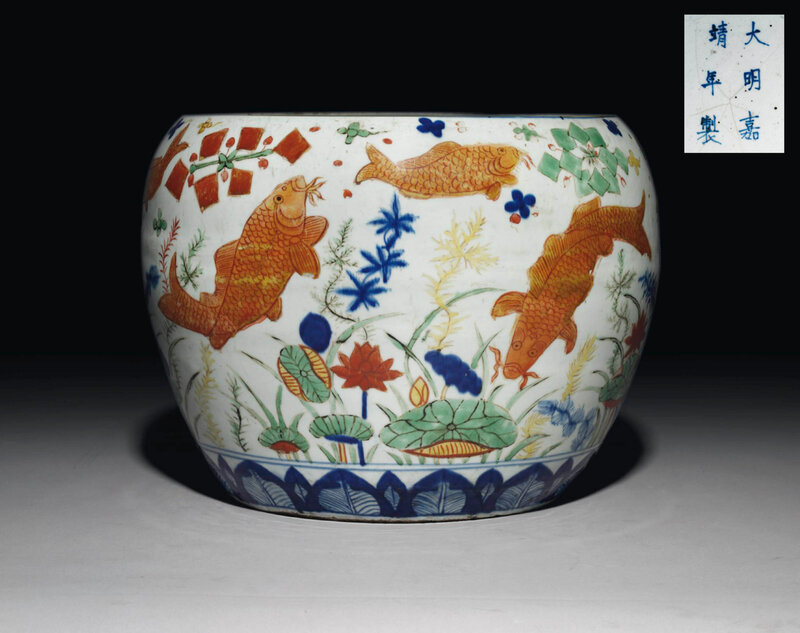A rare large wucai 'fish jar, Jiajing underglaze blue six-character mark and of the period (1522-1566)
Lot 311. A rare large wucai 'fish jar Jiajing underglaze blue six-character mark and of the period (1522-1566); 11¾ in. (30 cm.) high. Estimate £120,000 - £180,000. Price realised GBP 145,250. © Christie's Images Ltd 2012
The globular vase is finely decorated around the exterior with a continuous scene with eight golden carp depicted in different positions and swimming freely amidst water weeds. The foot is painted with a short band of upright leaves in underglaze blue.
From the estate of His Royal Highness the Prince Henry, Duke of Gloucester, K.G., K.T., K.P.
Note: Jars of this type are among the most admired of all the imperial porcelain of the Jiajing reign, since the wucai palette is particularly effective for the depiction of this theme and the large scale of the jar provides an excellent 'canvas' on which the ceramic decorator could arrange the undulating composition of fish and aquatic plants. Several jars of this type are to be found in major international museum collections in Europe, Japan and America. Five are preserved in China, including one which was excavated in 1967 in Hepingli, Chaoyangqu, Beijing, published in Wenwu, 1972: 6, p. 64, and inside back cover. Two others are preserved in Beijing. One in the collection of the Palace Museum (Fig. 1) is illustrated in The Complete Treasures of the Palace Museum - 38 - Porcelains in Polychrome and Contrasting Colors, Hong Kong, 1999, p. 16, no. 15. The other, excavated in Beijing in 1955, in the Chinese History Museum is illustrated inZhonggguo wenwu jinghua daquan, Taipei, 1993, p. 395, no. 772. Similar jars are also in the collections of the Shanghai Museum, illustrated by Liu Liang-yu in Survey of Chinese Ceramics - 4 - Ming Official Wares, Taipei, 1991, p. 212, lower left image, and the Tianjin Museum, illustrated in Porcelain from the Tianjin Municipal Museum, Hong Kong, 1993, p. 198, pl. 116.
Much of the popularity of fish as a decorative theme, especially in later dynasties, hinges on the fact that the word for fish (yu) is a homophone for the word for abundance or surplus (yu) - thus two fish represent doubled abundance and a gold fish (jinyu) symbolises an abundance of gold, or the idea of gold and jade, which represents wealth. Furthermore the word for carp is liwhich sounds like the word for profit, and thus two or more carp would represent multiple profit. The pronunciation of the word for carp also suggests the Confucian li of moral uprightness. In addition, the carp has another meaning, for it represents the scholar who strives to be successful in his civil service examinations and become a jinshi, and will thus gain a good official position. Legend tells of the carp swimming upstream every spring to the Dragon Gate on the Yellow River. If it succeeds in leaping over the gate, it is transformed into a dragon.
Christie's. Fine Chinese Ceramics and Works of Art 15 May 2012 London, King Street

/https%3A%2F%2Fprofilepics.canalblog.com%2Fprofilepics%2F1%2F0%2F100183.jpg)
/https%3A%2F%2Fstorage.canalblog.com%2F03%2F02%2F119589%2F96711876_o.jpg)
/https%3A%2F%2Fstorage.canalblog.com%2F11%2F31%2F119589%2F94773502_o.jpg)
/https%3A%2F%2Fstorage.canalblog.com%2F20%2F83%2F119589%2F94772815_o.jpg)
/https%3A%2F%2Fstorage.canalblog.com%2F26%2F72%2F119589%2F75604929_o.jpg)
/https%3A%2F%2Fstorage.canalblog.com%2F59%2F60%2F119589%2F26458628_o.jpg)



/image%2F1371349%2F20240325%2Fob_f3f664_telechargement-7.jpg)
/image%2F1371349%2F20240325%2Fob_bb86e3_telechargement.jpg)
/http%3A%2F%2Fstorage.canalblog.com%2F43%2F39%2F119589%2F129858579_o.jpg)
/http%3A%2F%2Fstorage.canalblog.com%2F66%2F03%2F119589%2F129677087_o.jpg)